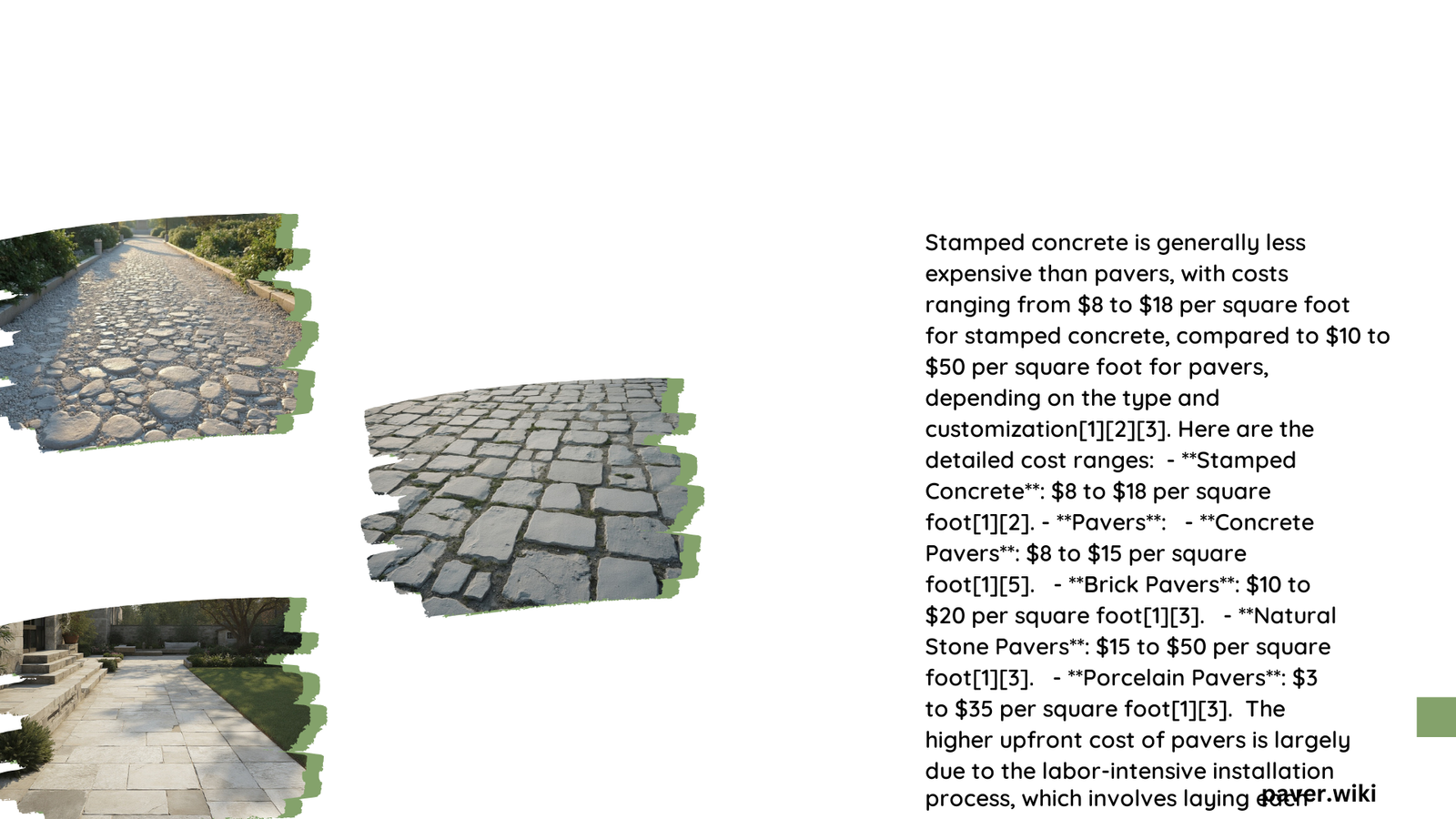When it comes to outdoor hardscaping, the choice between pavers and stamped concrete is a common dilemma. While stamped concrete offers a cost-effective solution initially, pavers often prove more expensive upfront but may offer long-term benefits. This comprehensive comparison explores the cost factors, durability, and aesthetic considerations of both options to help you make an informed decision for your outdoor space.
What Are the Initial Cost Differences Between Pavers and Stamped Concrete?
The initial cost is often a primary consideration when choosing between pavers and stamped concrete. Let’s break down the cost differences:
Stamped Concrete Costs
- Typically ranges from $5 to $18 per square foot
- Costs vary based on design complexity and location
- Generally less expensive for initial installation
Paver Costs
- Concrete pavers: $8 to $15 per square foot
- Brick pavers: $10 to $20 per square foot
- Natural stone pavers: $15 to $50 per square foot
- Porcelain pavers: $3 to $35 per square foot
As evident from these figures, pavers are generally more expensive than stamped concrete in terms of initial costs. However, it’s crucial to consider long-term expenses and benefits before making a decision.
How Do Installation Costs Compare?

Installation costs can significantly impact the overall expense of your hardscaping project:
Stamped Concrete Installation
- Faster installation process
- Single pouring and stamping procedure
- Lower labor costs compared to pavers
Paver Installation
- More labor-intensive
- Each paver must be laid individually
- Longer installation time, especially for larger areas
- Higher labor costs due to the intricate process
While stamped concrete may have an edge in installation costs, the ease of installation should be weighed against other factors such as durability and long-term maintenance.
What Are the Long-Term Maintenance Expenses?
Long-term maintenance is a crucial factor that can affect the overall cost-effectiveness of your choice:
Stamped Concrete Maintenance
- More prone to cracking over time
- Repairs can be costly and often noticeable
- May require sealing every few years to maintain appearance
Paver Maintenance
- More resistant to cracking
- Easier and less expensive to repair or replace individual pavers
- Generally lower long-term maintenance costs
Despite higher initial costs, pavers often prove more cost-efficient in the long run due to their easier maintenance and repair options.
How Does Durability Compare Between Pavers and Stamped Concrete?
Durability is a key factor in determining the long-term value of your hardscaping choice:
Stamped Concrete Durability
- Compressive strength: 3,000-4,000 PSI
- Lifespan: Up to 25 years
- More susceptible to cracking from freeze-thaw cycles and ground movement
Paver Durability
- Compressive strength: 8,000 PSI or greater
- Lifespan: Over 50 years
- Better resistance to cracking and environmental factors
Pavers clearly outperform stamped concrete in terms of durability, which can offset their higher initial cost over time.
What Are the Aesthetic Considerations?
Aesthetics play a significant role in choosing between pavers and stamped concrete:
Stamped Concrete Aesthetics
- Wide variety of patterns and textures
- Can mimic natural stone or brick
- Lacks the natural look and feel of actual stone or brick
- Color may fade over time
Paver Aesthetics
- Natural, high-end appearance
- Authentic look and feel
- Wide range of colors, shapes, and sizes
- Retains color better over time
While stamped concrete offers versatility in design, pavers provide a more authentic and enduring aesthetic appeal.
How Do Environmental Factors Affect the Choice?
Environmental considerations can impact the performance and longevity of your hardscaping:
Stamped Concrete Environmental Performance
- More susceptible to cracking from freeze-thaw cycles
- Can be slippery when wet
- May require more frequent sealing in harsh climates
Paver Environmental Performance
- Better resistance to freeze-thaw cycles
- Offers better slip resistance
- Can move with ground shifts without cracking
- Generally performs better in varying weather conditions
Pavers tend to offer superior performance in challenging environmental conditions, which can be a crucial factor in certain climates.
What Are the Cost-Benefit Ratios Over Time?
To truly understand which option is more expensive, we need to consider the cost-benefit ratio over time:
| Factor | Stamped Concrete | Pavers |
|---|---|---|
| Initial Cost | Lower | Higher |
| Installation Cost | Lower | Higher |
| Maintenance Cost | Higher over time | Lower over time |
| Durability | Lower | Higher |
| Repair Ease | Difficult and noticeable | Easy and less noticeable |
| Lifespan | Shorter | Longer |
While stamped concrete is less expensive initially, pavers often provide better value over their lifetime due to their durability, ease of repair, and lower long-term maintenance costs.
Conclusion: Which Is Truly More Expensive?
In conclusion, while stamped concrete is less expensive upfront, pavers can be considered more cost-effective in the long run. The higher initial cost of pavers is often offset by their superior durability, easier maintenance, and longer lifespan. When considering what’s more expensive between pavers and stamped concrete, it’s essential to look beyond the initial price tag and consider the total cost of ownership over the life of your hardscaping project.
Ultimately, the choice between pavers and stamped concrete depends on your specific needs, budget, and long-term expectations for your outdoor space. By carefully weighing the factors discussed in this article, you can make an informed decision that provides the best value for your investment.
References:
1. Aviara Pavers: Is Stamped Concrete Cheaper than Pavers?
2. Outback Landscape Inc.: Brick Pavers vs Stamped Concrete: Pros, Cons, and Costs
3. Bob Vila: Cost of Pavers vs. Concrete: Which Material Best Fits Your Budget?
